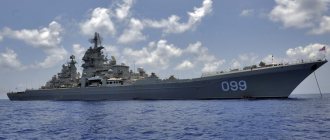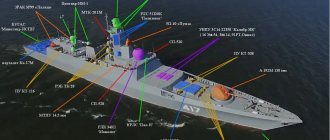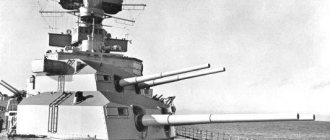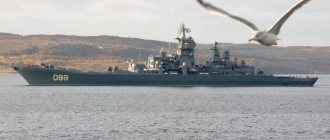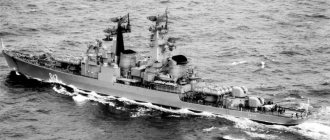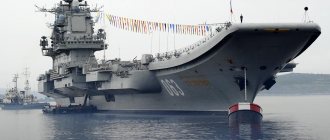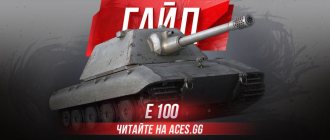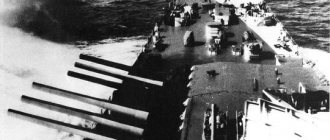Home » Alternative History » Alternative shipbuilding - Fleets that never existed » Heavy cruiser instead of a “pocket battleship”. German "project 66".
Alternative shipbuilding - Fleets that never existed
Sezh 03/23/2019 2923
13
in Favoritesin Favoritesfrom Favorites 8
Since Project 84 appeared, why not Project 66? Although initially, during the drawing process, it was project 66 that appeared, and after that - 84. The alternative is short, but as compensation - the “development” of this alternative into another.
* * *
When starting to design a new ship for the German fleet, German designers and the military had two points of view.
1. You must have strong guns in order to confidently gain the upper hand in a battle with a standard (“Washington”) heavy cruiser and even, if urgently necessary, engage in a more serious battle with the enemy. This approach was followed by the commander of the Reichsmarine, Admiral Zenker.
2. You must have high speed in order to confidently escape from any standard (“Washington”) cruiser, and, if absolutely necessary, even from a faster enemy (light or battle cruiser).
Through some debate, the point of view prevailed that the few German cruisers should avoid fighting (both light and heavy) enemy cruisers.
Thus, the initially planned armament on the new ship (Deutschland type) in the form of 6,283 mm was reduced to 6,240 mm, and this in turn was gradually transformed into 6,220 mm. Of course, it was possible to reduce it to the standard 203 mm, but a German raider must have a “long arm”. This is how the 220/58 mm gun appeared, officially designated as 20 cm (20/58 cm)
Type "Deutschland" ("Lutzow")
Despite the initial designs with 2 main battery turrets, there was (in the form of sketches) a three-turret version with 9 220 mm guns. But given that speed is still more important than firepower, the three-turreted version was relegated to the back burner. The auxiliary armament of the new ship (22 88-mm guns) could be called either super-powerful (if it was a question of fighting aircraft or destroyers), or insufficient - if used in a battle with cruisers (but a battle with an enemy cruiser at close range was considered unlikely). Subsequently, the 88 mm were replaced by large 105 mm guns.
The Deutschland's speed reached 34 knots - 1 knot faster than the fastest British cruiser, Esmeralda (33 knots).
In Europe, the German ship was met with interest - after all, compared to the Leizpig and Nuremberg, the new ship had added armament and size. But the German novelty was not of particular interest. Yes, it has its own characteristics (powerful air defense, two three-gun main battery turrets), but overall nothing interesting. Naturally, the Europeans might be interested in high speed, but the Germans, such modest people, announced that the Deutschland's speed was only 30.5 knots - just the speed of the British Hawkins.
While the first trinity of Deutschland ships (the Deutschland itself, Admiral Spee and Admiral Scheer) were being tested in Spain in conditions as close to combat as possible, the construction of new heavy cruisers continued.
Cruiser "L"
On one weekday in April 1958, port tugs turned the huge hull of a decommissioned cruiser with its bow towards the Sea Canal and slowly led it to the last berth - to the Kronstadt Ship Cemetery. The bright spring sun gently warmed the sides, was reflected in numerous portholes, the remains of the dismantled superstructures cast bizarre shadows on the deck, where, from under the torn off ball paint, armor of the “Wotan” brand gleamed dimly in places. The combat service of one of the most unusual ships of the Soviet Navy has ended.
In the early 30s, most of the leading naval powers entered the so-called “cruising race” - the construction of well-armored cruisers that did not fall under the restrictions of the “Washington Agreements”. On March 16, 1935, Adolf Hitler announced the denunciation of the peace treaty signed by defeated Germany after the end of the First World War, and began hastily arming the Third Reich. The Kriegsmarine leadership was clearly aware that it would not be possible to catch up with the main potential enemy at sea - Great Britain in terms of the number and power of surface combat ships. Therefore, instead of building monstrously expensive and resource-intensive dreadnoughts, the Germans developed the concept of building heavy cruisers and “pocket battleships” capable of long voyages and operations as single raiders. Officially, Germany was not constrained by the framework of the “Washington Treaty” in the tonnage of ships and the caliber of artillery, however, in order not to irritate the leading Western states, the Fuhrer and the head of the Kriegsmarine, Grossadmiral Erich Roeder, officially announced plans to build 5 cruisers of the “Admiral Hipper” type with a displacement of 10,000 tons with main caliber guns of 150 mm. The development of this type of vessel began in the fall of 1934, but when the plan was implemented, it became clear that it was not possible to keep within the stated framework. The installation of lighter “one hundred and fifty millimeters” did not result in a large reduction in tonnage, but it noticeably reduced armor penetration parameters; questions also periodically arose regarding the choice of the type and methods of mounting the main power plant; a lot of other minor, but no less significant, technical problems remained unresolved. Completely disregarding various agreements and restrictions, the Reich leadership made a Solomonic decision to build ships with a displacement of 15-20 thousand tons, to return to the classic caliber of 203 mm with an arrangement of two guns in 4 gun turrets, the minimum thickness of the main belt armor being 80 mm. The lead ship of this project (symbol "cruiser N") was laid down in July 1935 at the Bloom and Voss shipyard in Hamburg; in August, Deutsche Werke in Kiel began construction of the second ship from the same series (cruiser G), the third order (cruiser J) was taken over by the Krupp family. The fourth (K) and fifth (L) cruisers began to be assembled in Bremen in December 1936 and August 1937, respectively.
With Hitler's rise to power, the close economic and military cooperation that had existed between the young Soviet state and the Weimar Republic began to decline. In order to defuse the tension between the two powers, the USSR began to look for ways of rapprochement with Germany by concluding a number of trade and economic contracts. As a result of the efforts made, on April 9, 1935, the “Agreement between the government of the USSR and the government of Germany on additional orders of the USSR in Germany and the financing of these orders by Germany” was signed. In accordance with it, the Soviet side received the right to place orders to German industrialists for 200 million marks under the guarantee of the Reich government. These orders were supposed to be equipment for factories, machines, apparatus, electrical products, equipment for the oil and chemical industries, vehicles, laboratory equipment, etc. This also included technical assistance. In reality, with this loan, the USSR received from Germany factory equipment and other goods worth 151.2 million marks. Deliveries of Soviet goods to cover the loan were to begin at the end of 1940 and end in 1943.
On August 19, 1939, a few days before Joachim von Ribbentrop’s visit to Moscow to sign the famous “Non-Aggression Pact,” the Soviet government received an agreement in principle from the German side to allocate another loan in the amount of about 200 million marks, providing, among other things, , the possibility of purchasing the most modern weapons in Germany. At the end of September, to get acquainted with the latest models of German military equipment, a representative delegation of 48 people arrived in Berlin, which included not only diplomats, but also many leading experts in the field of tank building, aircraft manufacturing and other industries. The delegation was headed by People's Commissar I.F. Tevosyan. Following Stalin's very reasonable decision that “A ship purchased from a supposed enemy is equal to two: one more from us and one less from the enemy,” special attention was paid to attempts to acquire large warships. Many options were considered, but the German side was reluctant to make concessions and after lengthy negotiations, Germany gave up only one ship - the heavy cruiser Lützow, being built at the Bremen shipyard. As a result, the Soviet Union received, albeit at 50% readiness, a completely modern combat unit. And so on February 11, 1940, an agreement was signed to purchase “Luttsov”, which received the name “Project 53” from the Soviet side, for 104 million marks. On April 15, the “purchase,” accompanied by two sea tugs, slowly rolled away from the outfitting wall and on May 31 moored in Leningrad at the berth of the Baltic Plant No. 189. Together with the cruiser, a team of German engineers and technicians arrived, numbering about 70 people under the leadership of Rear Admiral Otto Feige.
According to German-Soviet plans, the final commissioning of the cruiser was scheduled for 1942, however, the planned work schedules suddenly began to be violated due to the disruption of supplies of equipment and materials by the German side, as well as facts of direct failure to fulfill their duties and deliberate red tape of German technical specialists. Soviet and Russian historiography has repeatedly stated that the Germans deliberately agreed to cheat. The war with Soviet Russia was practically decided, and Germany clearly had no intention of helping arm its future enemy. Numerous witnesses and eyewitnesses point to deliberate sabotage on the part of the Germans. Deputy shop manager of the Baltic Shipyard B.P. Favorov, in his book of memoirs “On the stocks under fire,” writes the following: “So, gradually, day after day, the work on the ship was delayed, the planned deadlines were missed. Such tactics of representatives of German companies naturally led us to believe that all this was being done with a certain intent, in order to delay the completion and commissioning of the cruiser as much as possible. The calculation was this: without the Germans, we ourselves, they say, would not be able to cope with the completion of the Lyuttsov. He is echoed by former petty officer S.Ya Prikot, who served on the ship as a boiler operator until July 1941: “The Germans did not deliver a number of important parts. For example, the joints on pipelines are corrugated. And the steam pressure there was 52 kg. It was impossible to produce such joints in a short time at our factories. And don’t give steam! This means the ship is unable to move. One pump for feeding the boilers was not supplied, the pump was from an old cruiser, we discovered this, and the pump was sent back to Germany. The new one was never installed. So they did it deliberately." Documentary evidence from the German side suggests the opposite. For example, the official in charge of Soviet-German economic relations, German Foreign Ministry official Karl Julius Schnure, in a memorandum prepared for his superiors dated May 15, 1941, reported the following: “The construction of the cruiser “L” in Leningrad continues according to plan, German supplies are arriving on schedule" (State security bodies of the USSR in the Great Patriotic War.) T.1. The day before. Book 2. “January 1 - June 21, 1941.” The Germans quite reasonably explained the interruptions in supply that occurred with objective reasons: the ongoing war with England, which caused difficulties with materials, the flow of which was urgently redirected to the needs of the front, and the shortage of qualified labor due to the massive conscription of industrial workers into the army.
However, work to commission the ship continued. In the bow and stern turrets, 203 mm guns were installed in standard places, 20 and 37 mm anti-aircraft guns arrived from Germany, and the necessary power equipment was gradually put into operation. Despite the massive departure of German specialists and the lack of necessary parts, the plant workers and team, led by Captain 2nd Rank A.G. Vonifatiev, made every effort to bring the cruiser into combat-ready condition. By June 22, 1941, the cruiser was 70% ready; by this time, the first level of the superstructure, the bow and stern lower towers, the base of the navigation bridge, the chimney and the lower part of the main mast rose above the hull. Sea trials were scheduled for August. "Petropavlovsk" was staffed 100% by officers and 60-70% by foremen and sailors, the total crew number was about 1000 people.
On the night of June 21-22, the ship's crew was alerted: it was announced that it was necessary to receive and place on the cruiser 50 people from the sunken destroyer "Gnevny". Exhausted people began to descend from the arriving trucks, many half-naked, some could not walk on their own, and their comrades led them by the arms. In response to the questions of the alarmed sailors about what happened, one of the new arrivals briefly exhaled: “War...”.
From the first days, the Baltic Fleet was actively involved in the fight against the invaders. In Leningrad, by order of the People's Commissar of the Navy N.G. Kuznetsov, on July 5, 1941, the headquarters of the Naval Defense of Leningrad and the Ozerny region was organized, Rear Admiral F.I. Chelpanov was appointed commander. Energetic measures were taken to equip additional coastal battery positions, accelerate the commissioning of warships undergoing repairs, and form marine detachments. Two companies of Petropavlovsk soldiers joined the ranks of the Marines. Petty Officer S.Ya. Prikot recalled it this way: “So, we decided to mothball the cruiser. Prepare the main caliber for firing; electromechanical specialists will go to the front. And immediately in the courtyard they read out: “...List of the battalion of the cruiser “Petropavlovsk.” The battalion commander is Lieutenant Commander Socheykin. Three steps out of order! First company: company commander, senior engineer-lieutenant Schaefer. Three steps out of order! First platoon. Platoon commander Lieutenant Ershov!...” This is literally how the order was read to us, and this is how everyone left. “First squad, platoon commander - Sergeant Major Prikot!” He went out and stood up. My sailors and subordinates were also read out. Twelve people under my command. Everyone knew each other, so they stuck together. From the next day we went to the factory, preserved the cruiser, filled everything with oil, and attached tags. And in the evening - with training rifles to the Kirov Palace, to the place where they went to dances - for ground training. This lasted until July, about twenty days. And after that they issued weapons: for 12 people in the squad, 2 light machine guns, the rest, except the squad commander, received SVT rifles plus grenades. As a squad commander, my PPD is the same as the Finnish one.” Of course, sending highly qualified specialists, on whose training the fleet had spent many years, as privates into the infantry was the height of wastefulness, but the Soviet command had no choice: the enemy was rushing towards Leningrad. Only the gunners and a few sailors from the various ship services necessary to maintain the life support of the ship remained on the cruiser. The ship's power plant was hastily installed, the completion of the shell feeding mechanisms and other necessary work for conducting successful artillery fire continued. On August 15, 1941, the naval flag of the RKKF was raised on the cruiser, which received the name "Petropavlovsk", and, in accordance with its condition, the ship was included in the detachment of Red Banner Baltic Fleet ships under construction along with the destroyers "Opytny", "Strogiy" and "Stroyny".
Rice. The destroyer "Experienced" fires at the enemy
The city defense headquarters decided to transfer the Petropavlovsk to a firing position in the Coal Harbor area. Since the cruiser did not have high superstructures, it was possible to camouflage it relatively well: the ship’s hull was “lost” among various coastal structures. The ship was brought to the pier and connected to the coastal power plant, because by the beginning of the active phase of the battles for the city, the ship’s crew, which had been reduced to the limit, managed to fully commission only one diesel generator station.
When the Germans approached Leningrad in early September, work was found for the cruiser's 203 mm guns. Artillery observers were sent ashore in advance, and on September 7 the cruiser received its first target designation: a large concentration of German troops and equipment was noted in front of the front of the 21st NKVD division. The Petropavlovsk guns opened fire for the first time, sending 122 kilogram shells at the enemy. The Germans rushed about and began to retreat in panic. New goal: a train with troops is unloading in the area of the Uritsk station. The cruiser's Krupp guns roared again. Within a few minutes the train was destroyed. Probably, the soldiers of the 36th motorized division of the Wehrmacht would be quite surprised to learn that they were being destroyed by the former German cruiser Lützow using German guns and German shells. In just the first week of fighting, the cruiser fired 676 shells, causing significant damage to the troops of the 18th German Army, in particular, Petropavlovsk very effectively conducted counter-battery warfare, its fire thwarted several attempts by German troops to break through the defenses in the area of the railway to Leningrad and in the shortest possible time ways to enter the city. As Fleet Admiral N.G. recalled in his book “On the Course to Victory” Kuznetsov: “The unfinished cruiser Petropavlovsk greatly annoyed the Nazis with its artillery fire.” On September 11, an accident occurred on the ship: during live firing, on the 22nd shot, a shell explosion in the barrel bore tore the barrel of the left gun of turret No. 1. When inspecting the scene of the incident, a defect was discovered: a shell on the barrel that had been carefully repaired and painted over by the Germans. Deliberate sabotage or manufacturing defect? An exact answer is unlikely to ever be obtained. On September 10, the troops of Army Group North reached the shore of the Gulf of Finland, which gave them the opportunity to more carefully adjust the fire of their long-range artillery, and field guns to shoot right through the main waterway between Kronstadt and Leningrad - the Sea Canal. Enraged by the successful actions of the Petropavlovsk sailors, the Germans decided to destroy the cruiser at any cost. A series of air raids followed, which were successfully repelled by the ship's anti-aircraft gunners. However, from the dropped bombs, which, although they did not cause “ex-Lutzov” any harm, the port buildings covering him from enemy eyes caught fire, and the supplying coastal power substation was disabled. The position of the cruiser, deprived of power and now in direct visibility of the enemy, became threatening. The ship's commander, Captain 3rd Rank A.K. Pavlovsky, urgently called tugboats, but in the meantime the cruiser continued to fire all night.
On September 17, the heavy 210 mm howitzers of the 768th motorized division of the Wehrmacht rained down the first shells on the stationary ship. The Petropavlovsk gunners tried to respond, but the Germans saw the target perfectly and shot very accurately. Almost one of the first shells knocked out generator room No. 3 - the last remaining source of energy and the ship was completely de-energized. The cruiser turned into a defenseless target, which enemy artillery began to mercilessly beat. During the day, Petropavlovsk received more than 50 hits from shells of various calibers, mostly 210 mm, which is quite enough to sink almost any ship. A fire broke out on the cruiser, which was impossible to put out due to numerous damages in the fire mains. Sea water began to flow through the holes. The team hastily left the sinking ship, having previously evacuated all the wounded. On September 19, having taken on a huge mass of water, the warship sat down on the ground, leaning heavily on the side of the quay wall. The crew lost 10 people killed and 30 wounded. However, the cruiser did not give up. At night, observing all precautions, the remaining members of the team boarded the ship along with the arriving specialists from ship repair plant No. 189. They secretly dismantled the anti-aircraft weapons, which were extremely necessary for equipping the ships of the Ladoga military flotilla.
The difficult situation at the front forced the Soviet command to further reduce the crew; another company of marines was formed from Petropavlovsk sailors and hastily sent to the front line, to land on Peterhof.
The city defense headquarters decided not to abandon the shot cruiser to the mercy of fate; it was decided to carry out work to lift and tow it to a safe place. A small crew and EPRON specialists fought for a year to save the ship. It was especially difficult for people in winter: cold, hunger, and even the front line of the German troops was only three kilometers away. Noticing the slightest movement in the area where the ship was forced to stay, the Germans opened massive artillery and mortar fire. While maintaining all measures of light and noise masking, an unprecedented struggle was going on in the flooded rooms of the cruiser. Baltic sailors pumped out water from the compartments with weak portable pumps, divers sealed holes outside the hull, mechanics restored pipelines and electrical wiring. Things went faster when ship specialists managed to “revive” part of the ship’s pumps. And on September 10, 1942, an iron colossus 212 meters long and 22 meters wide finally surfaced. It became possible to repair the damage in the part of the hull that abutted the pier; by morning a patch had been put in place, and cement boxes were installed over the holes. It was beginning to dawn, the Germans could notice that the warship had come to life and bombard it with shells again, so the order was given to open the kingstons and sink the cruiser again.
The next attempt was repeated a few days later. Powerful ship pumps quickly pumped out almost 1,600 tons of water; a tug quietly creeping up picked up the steel giant and quickly dragged it into the Neva. However, here too, failure awaited the Red Navy: within a year the fairway had changed greatly and the cruiser ran aground. The refloating work continued until dawn, and in the morning the familiar picture was again before the eyes of German observers: the tilted cruiser stood calmly in its original place. On the moonless night of September 17, 1942, another attempt to save the ship was successful. In the morning, the dumbfounded Germans saw an empty pier, and the securely moored Petropavlovsk was already standing at the pier of the Baltic Shipyard.
In December 1942, repairs on the ship were completed, and the day before the new year, 1943, the cruiser was towed to the iron wall of the Trade Port, from where it again opened fire on the enemy. "Petropavlovsk" was included in the 2nd artillery group of the fleet, which also included the battleship "October Revolution", the cruisers "Kirov" and "Maxim Gorky", as well as several destroyers. The cruiser's artillery was commanded by Senior Lieutenant Y.K. Grace. The guns of the warship continued to smash the enemy, providing assistance to the ground forces. German technology did not let us down; the fire was extremely accurate. “Enemy CP at height 112 (east of Krasnoe Selo). Two direct hits on a concrete pillbox. The corner of the pillbox was demolished and the top ceiling was destroyed. There are 31 craters within a radius of 100 meters. The shooting of the cruiser "Petropavlovsk" - testifies in the book "Soviet surface ships in the Great Patriotic War" by G.I. Khorkov. "Petropavlovsk" took part in the Krasnoselsko-Ropshinskaya offensive operation, firing 250 shells on the first day, January 15, 1944. From January 15 to 20, this number increased to 800 with a barrel of 300 shots. And in just 31 shellings, 1036 shells were fired at the enemy. The guns of the crippled ship were not too spared: it accounted for about a third of the firing carried out and the shells fired by the 2nd artillery group of the fleet, especially since the Germans, for some reason, supplied almost double ammunition before the war. “According to reports from coastal observation groups and our troops, the actions of the Petropavlovsk artillery turned out to be very effective. On January 19 alone, the cruiser-battery was credited with 3 guns, 29 vehicles, 68 wagons and 300 killed enemy soldiers and officers,” V. Kofman quotes the KBF report in the book “Princes of the Kriegsmarine.” But gradually the front moved away, and firing became more and more difficult. The ship fired its last salvos on January 24, 1944. This marked the end of Petropavlovsk's combat service. On September 19, 1944, the cruiser was renamed Tallinn.
Rice. Heavy cruiser Seydlitz in Pillau
After the war, several options for completing the ship were considered, one of which was very original. In 1945, in Pillau Bay (now Baltiysk, Kaliningrad region of the Russian Federation), Soviet troops captured the cruiser Seydlitz, which was blown up by the Germans. An opportunity has arisen, using one ship as a “spare parts warehouse” to bring the job started 5 years ago to its logical conclusion. However, having considered all the options, the Navy command considered the costs of restoring a foreign and already obsolete cruiser excessive. In addition, the hybrid power plant installed on this type of ship turned out to be difficult to operate and repair, and did not meet the requirements of post-war domestic shipbuilding.
After the war, the Tallinn began to be used as a non-propelled training vessel until March 11, 1953, when it was once again renamed the Dnepr. The cruiser was turned into a floating barracks, in which the crews of warships being repaired at the Leningrad docks lived. The next wave of renamings was not long in coming; on December 27, 1956, the former combat ship received the name PKZ-112. On April 3, 1958, the former "Lutzow" was excluded from the lists of the fleet.
Rice. Landmarks for German artillery firing
In some works of modern authors on this topic, one often encounters censure of the USSR government for the purchase of an unfinished cruiser, saying that the price is too high, and with the currency spent it was possible to buy or build something more necessary. This judgment shows only one thing: their superficial knowledge of the realities of the outbreak of the war. In the 30s, out of malice or incompetence, now listed as an “innocent victim of Stalin’s repressions,” Marshal Tukhachevsky, who was directly responsible for weapons, by a strong-willed decision concentrated the efforts of the design bureau and directed the funds and capacity of weapons factories to the implementation of various fantastic ideas such as “universal anti-tank anti-aircraft guns" or air guns with a caliber of 250 mm. He stopped the development of long-range artillery, and by the beginning of the war the USSR approached with only a few field guns firing at a distance of over 30 km. The artillery systems that were then part of the Leningrad Front had a maximum firing range of 20-25 km, standard German guns of infantry and motorized divisions confidently hit targets at 25-30 km. It turned out that the Germans could raze the city to the ground with complete impunity using artillery alone. However, it turned out that the fleet blocked in the Marquis Puddle in September 1941 turned out to be the savior of Leningrad: for example, the guns of pre-revolutionary battleships could send a heavy projectile at a distance of up to 44 km. Eight-inch "Luttsova" fired at 33.5 km, which made it possible to effectively conduct counter-battery combat against any type of German guns. During the war, the cruiser fired more shells at the enemy than any other ship of the Baltic Fleet, thereby saving many thousands of lives of Soviet soldiers and civilians of the heroic city on the Neva without monetary equivalent.
Admiral Hipper class
Unlike the harmless raider/corsair Deutschland, the Hipper was more of a hunter cruiser. Or actually a full-fledged heavy cruiser. The main caliber is still the same 22 cm guns, now in the amount of not 6 pieces, but already 9 pieces; but the auxiliary weapons were almost halved - 14 105-mm guns.
When designing the Hipper, the Germans removed the three-turreted Deutschland sketches from a distant drawer, but reworked the project. Now using a linear-elevated scheme, the Germans made the silhouettes of the “Admiral Hipper” type similar to the silhouettes of the “Leizpig” and “Nuremberg” types.
Of course, for a “hunter” such an arrangement of main caliber guns was strange. After all, his “game” is light cruisers, which “Hipper” with its 32 knots (official 30.5 knots) could catch up with. But here it was necessary to take into account not the “cowardice” of the Germans, but the calculation that they would have to escape (and most likely with a fight) from a couple of heavy British cruisers. And here a stern salvo from 6 22 cm guns was preferable to one from 3 guns.
Another change compared to the Deutschland was a steam turbine unit instead of a diesel one.
Subsequently, a modified version of the “Hipper” was proposed - the anti-aircraft weapons were strengthened by installing a 105-mm bow mount.
Notes[edit]
Notes
- "L/60" denotes the length of the weapon in calibers. The length of a 60 caliber gun is 60 times its width in diameter.
Quotes
- Jump up ↑
Williamson, pp. 4–5. - Koop & Schmolke, page 9.
- ^ abcde Groener, page 65.
- ^ abc Groener, page 66.
- Williamson, p. 43.
- ^ abc Groener, page 67.
- ^ ab Rohwer & Monakov, page 113.
- Philbin, page 46.
- ^ a b Philbin, page 120.
- Rover & Monakov, page 140.
- Philbin, pp. 120-121.
- Philbin, pp. 121-122.
- Philbin, page 122.
- Rover & Monakov, pp. 195-196.
- Philbin, pp. 122-123.
- Philbin, page 123.
- Philbin, page 125.
- Philbin, pp. 127-128.
- ^ a b Philbin, page 128.
- ^ abc Gardiner & Chesneau, page 328.
- Gardiner and Chenault, p. 229.
- Ward, p. 143.

